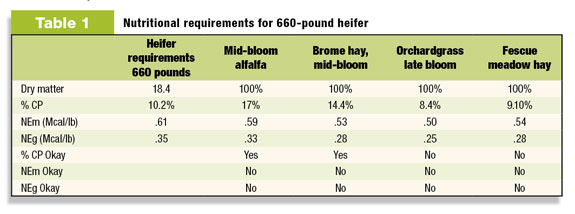We expect a great deal out of our replacement heifers; therefore it is critical that we utilize approved management practices that will help to develop them properly.
A well-developed heifer is one that maintains her body condition score of 5 or better, is cycling prior to the breeding season and has the structure and frame to carry a calf.
The first duty of the heifer is to produce a heavy weaned calf. To do this, she must be of sufficient weight and age to be cycling at the beginning of the breeding season.
As producers, we need to choose moderate-framed, growthy heifers and feed them so they reach their genetic potential.
Developing heifers requires special consideration when feeding as compared to a mature cow. As yearlings they are still growing rapidly, gaining 1.25 to 1.75 pounds per day, which is their primary purpose.
They need to reach 60 to 65 percent of their mature weight by 13 to 15 months old to achieve puberty. Age and weight at puberty varies based on breed differences, with Continental-breed heifers reaching puberty at a later age and at heavier weights than English-breed heifers.
How well heifers are developed determines their lifetime productivity in the herd. It is well documented that once a late calver, always a late calver.
Research shows that if a heifer calves for the first time as a 2-year-old, she will produce 330 pounds more calf than if she calved as a 3-year-old.
The key to heifer profitability in the herd is longevity. Therefore, heifers need a good start to become a productive cow.

Feeding heifers to match their nutrient requirements is critical to a good start (see Table 1). Heifers have different requirements for dry matter intake, protein and energy than that of a mature cow.
A balanced ration for replacement heifers takes into consideration:
- Dry matter intake – how much feed the heifer will consume
- Crude protein – how much protein the heifer needs to grow and develop
- Energy requirements – how much energy the heifer needs for maintenance and gain
Heifers need both adequate protein and energy to cycle and conceive. Most “good-quality” hay will meet protein requirements but fall short in energy, so supplements may be necessary.
Low-quality hays such as meadow hay or fescue hay may be deficient in both energy and protein. All forages should be analyzed for nutrient content.
Feed loses a portion of its energy value during digestion. Of the total amount of energy contained in a ration, only 40 percent is used by the animal for maintenance and production.
The other 60 percent is lost as waste (feces and urine), methane gas and energy used for fermentation and metabolism.
A medium-framed heifer weighing 650 pounds will need to reach her target weight 30 days prior to breeding.
If her projected mature weight is 1,250 pounds, she needs to achieve 60 percent of her growth and should weigh 750 pounds.
If a producer is working with an April 15 breeding date, the heifer needs to reach her target weight by March 15.
If you start her on a “developing” ration Jan. 15, this would give you 60 days to have her reach the 750 pounds.
The heifer will need to gain 1.6 pounds per day during the 60-day feeding period to gain the 100 pounds needed to go from 650 to 750 pounds.
If you feed a ration containing only mid-bloom alfalfa, the heifer will meet her protein requirement to gain 1.6 pounds per day, but will be lacking in energy (See Table 1). The heifer will need to receive a supplement to meet her energy requirements.
If a supplement is needed, it can take place with a variety of feedstuffs such as corn, barley or oats. As little as 2 pounds of some supplements will raise the energy level of the ration. Byproducts such as corn gluten feed, distillers grains and wheat midds provide energy and protein.
Producers should have their heifer development ration analyzed to ensure it is balanced and meets the heifer’s protein and energy requirements in a cost-effective manner.
Assistance in balancing a ration can be obtained from a consulting nutritionist or an extension professional and is often very beneficial.
Alternatively, producers can obtain information from programs such as Nutrient Requirements of Beef Cattle (http://www.nap.edu/catalog.php?record_id=9791) or Taurus (http://animalscience.ucdavis.edu/extension/Software/Taurus/index.htm) found at the mentioned websites.
Meeting the nutritional demands of developing heifers determines the success of your breeding program during the current year, the length and success of your calving season next year and how productive that heifer will be over her lifetime.
Producers that feed a straight hay ration during heifer development may not be allowing heifers to meet their energy requirements for proper development and growth.
Take time to evaluate your feeding program and make sure you are meeting your heifers’ protein and energy requirements. ![]()
PHOTO
Top: A medium-framed heifer weighing 650 pounds will need to reach her target weight 30 days prior to breeding. Staff Photo.

Shannon Williams
Extension Educator
Beef Specialist
University of Idaho
shannonw@uidaho.edu
John Hall
jbhall@uidaho.edu







